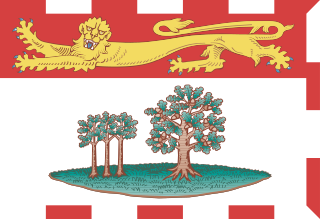Related Research Articles

Nova Scotia is one of the thirteen provinces and territories of Canada. It is one of the three Maritime provinces and one of the four Atlantic provinces. Nova Scotia is Latin for "New Scotland."

Prince Edward Island is one of the thirteen provinces and territories of Canada. It is the smallest province in terms of land area and population, but the most densely populated. The island has several nicknames: "Garden of the Gulf", "Birthplace of Confederation" and "Cradle of Confederation". Its capital and largest city is Charlottetown. It is one of the three Maritime provinces and one of the four Atlantic provinces.

The Bay of Fundy is a bay between the Canadian provinces of New Brunswick and Nova Scotia, with a small portion touching the U.S. state of Maine. It is an arm of the Gulf of Maine. Its tidal range is the highest in the world. The name is probably a corruption of the French word fendu, meaning 'split'.

Lunenburg is a port town on the South Shore of Nova Scotia, Canada. Founded in 1753, the town was one of the first British attempts to settle Protestants in Nova Scotia.

Halifax is the capital and largest municipality of the Canadian province of Nova Scotia, and the largest municipality in Atlantic Canada. Halifax is one of Canada's fastest growing municipalities, and as of 2022, it is estimated that the CMA population of Halifax was 480,582, with 348,634 people in its urban area. The regional municipality consists of four former municipalities that were amalgamated in 1996: Halifax, Dartmouth, Bedford, and Halifax County.

Diana Caroline Whalen is a Canadian politician, who represented the electoral district of Halifax Clayton Park in the Nova Scotia House of Assembly from 2003-2013, and Clayton Park West from 2013-2017, as a member of the Nova Scotia Liberal Party.

Rodney Joseph MacDonald is a Canadian politician, educator and musician who served as the 26th premier of Nova Scotia from 2006 to 2009 and as MLA for the riding of Inverness in the Nova Scotia House of Assembly from 1999 to 2009.

BC Parks is an agency of the British Columbia Ministry of Environment and Climate Change Strategy that manages all of the, as of 2020, 1,035 provincial parks and other conservation and historical properties of various title designations within the province's Parks oversaw of the British Columbia Parks and Protected Areas System. The Lieutenant Governor-in-Council created the agency on March 1, 1911, through the Strathcona Park Act. The agency is charged with a dual role of preserving the ecological and historical integrity of the places entrusted to its management, while also making them available and accessible for public use and enjoyment.

Cape Chignecto Provincial Park is a Canadian provincial park located in Nova Scotia. A wilderness park, it derives its name from Cape Chignecto, a prominent headland which divides the Bay of Fundy with Chignecto Bay to the north and the Minas Channel leading to the Minas Basin to the east. The park, which opened in 1998, is the largest provincial park in Nova Scotia. It also anchors one end of the UNESCO Cliffs of Fundy Global Geopark.
Crown corporations in Canada are government organizations with a mixture of commercial and public-policy objectives. They are directly and wholly owned by the Crown.

Ben Eoin is a community in the Canadian province of Nova Scotia, located in the Cape Breton Regional Municipality.
The Muskrat Falls Generating Station is a hydroelectric generating station in the Labrador region of the Province Newfoundland and Labrador, Canada, to develop the remaining 35 per cent of the Churchill River that was not developed by the Churchill Falls Generating Station. The station at Muskrat Falls has a capacity of over 824 MW and provides 4.5 TWh of electricity per year.

Timothy Jerome Houston is a Canadian politician who is the 30th and current premier of Nova Scotia since 2021. He was first elected to the Nova Scotia House of Assembly in the 2013 provincial election. A member of the Progressive Conservative Party of Nova Scotia, he represents the electoral district of Pictou East. Houston also served as the leader of the opposition from 2018 to 2021. He and the Progressive Conservative party won a majority government in the 2021 Nova Scotia general election, becoming the first Progressive Conservative premier since 2009.

Iain Thomas Rankin is a Canadian politician who served as the 29th premier of Nova Scotia from February 23, 2021, to August 31, 2021. He serves in the Nova Scotia House of Assembly for the Nova Scotia Liberal Party, representing the electoral district of Timberlea-Prospect. Rankin was first elected in the 2013 Nova Scotia general election and was re-elected in the 2017 general election. On February 6, 2021, Rankin was announced the Leader of the Nova Scotia Liberal Party.
The Ministry of Environment and Protected Areas of Alberta is the Alberta provincial ministry of the Executive Council of Alberta responsible for environmental issues and policy as well as some, but not all, parks and protected areas in Alberta.

The Blue Mountain-Birch Cove Lakes Wilderness Area is located in Halifax, Nova Scotia, Canada. Considered to be of high ecological value, it is one of 40 designated wilderness areas in the province.

On October 17, 2018, cannabis was legalized in Canada for recreational and medical purposes. It was already legal for medicinal purposes, under conditions outlined in the Marijuana for Medical Purposes Regulations issued by Health Canada, and for seed, grain, and fibre production under licence by Health Canada.
Mira River Provincial Park is a provincial park situated on the Mira River in Cape Breton County, Nova Scotia, 22 kilometres (14 mi) from Sydney and 17 kilometres (11 mi) from the Fortress of Louisbourg National Historic Site of Canada. Opened in 1967, the 87.49 hectares property offers camping sites and a range of opportunities for outdoor recreation, including picnicking, swimming, canoeing, kayaking, biking, front-country hiking, boating, fishing, cross-country skiing, snowshoeing, and geocaching.

The Sentier Nepisiguit Mi'gmaq Trail is a 147 kilometre wilderness hiking and backpacking trail in New Brunswick, Canada that follows the Nepisiguit River from the Daly Point’s Nature Reserve in Bathurst to Mount Carleton Provincial Park. Officially opened for hiking in 2018, the trail is a recommissioned ancient Mi'gmaq portage route and is one of the eleven signature hiking trails in New Brunswick.
The COVID-19 pandemic in Nova Scotia is an ongoing viral pandemic of coronavirus disease 2019 (COVID-19), a novel infectious disease caused by severe acute respiratory syndrome coronavirus 2 (SARS-CoV-2). On March 15, 2020, three presumptive cases in Nova Scotia were announced. All three were travel-related.
References
- 1 2 Gorman, Michael (18 December 2019). "N.S. won't protect land with 'globally rare' ecosystem that company eyes for golf resort". CBC.
- 1 2 Palmeter, Paul (14 June 2022). "Owls Head, once considered for controversial golf course, designated as provincial park". CBC.
- ↑ "Owls Head Provincial Park Designation". Province of Nova Scotia. 14 June 2022.